Warning for Aboriginal and Torres Strait Islander viewers. This article contains images of deceased persons.
Summer is on its way out, blackberry season has begun, the harvest season is on our doorstep, and the ‘dog days’ of summer are upon us. Where does that saying come from? In this week’s episode we will explore why this time of year is referred to as ‘the dog days,’ (it has something to do with the star Sirius).
We’ll learn about the constellation Canis Major, some myths and legends about it and its stars, and some First Nations star lore. Then, to honour the ‘dog star’ Sirius, we’ll also learn about our native Australian canid predator, the dingo, as well as the origins of the famous Australian Cattle Dog and the Australian Kelpie. Funnily enough, while researching for this article, I found out that the Australian Shepherd isn’t Australian at all but rather originates from the western United States. Go figure!
The Dog Days
Have you ever wondered why the hottest days of summer are called the dog days? You might think it has something to do with dogs lying around in the heat, but the origin of this phrase is astronomical.
The dog days are named after the star Sirius, which is also known as the dog star because of its location in the constellation Canis Major (Latin for Great Dog). Canis Major contains two important stars. VY Canis Majoris is a red hypergiant star and the largest star discovered so far. Sirius (Alpha Canis Majoris) is the brightest star in the night sky and is a binary star system (two-star system). It consists of a main star twice as massive as our Sun, orbited every 50 years by a white dwarf star.
Ancient civilisations such as the Babylonians, Egyptians, and Greeks noticed that Sirius rose and set with the sun during a period of about 40 days in midsummer. They believed that the extra heat from Sirius added to the sun's heat, making this the hottest and most uncomfortable time of the year. The Greeks and Romans associated this time with drought, disease, and bad luck and called this period the dies caniculares or the ‘days of the dog star’.
Today, we still use the term ‘dog days’ to refer to the hottest days of summer, usually between early July and mid-August in the Northern Hemisphere and the late summer month of February, in the Southern Hemisphere.
Sirius is significant for many cultures around the world. In ancient Egypt, the appearance of Sirius in the sky corresponded with an important event that was vital to survival, the flooding of the Nile River. In ancient Mesopotamia, the Babylonians considered Sirius to be an arrow aimed at Orion, with the bow consisting of the southern stars of Canis Major and a part of the Puppis constellation. It was called the ‘Dog Star’ by the ancient Greeks due to its prominent position in the Canis Major constellation. Its appearance during the hottest days of summer gave rise to the term ‘dog days’.
Canis Major was seen by the ancient Greeks as Orion’s hunting dog, helping him to fight Taurus the bull or pursuing Lepus, the hare. Orion’s second hunting dog Canis Minor was added to the story by ancient Romans. Canis Major also appears in ancient Greek mythology as Lealaps, the fastest dog in the world, destined to catch anything it pursued:
Zeus gave Laelaps to Europa as a present, along with a javelin that could not miss. The gift proved to be an unfortunate one, as Europa herself met her end at the hands of her husband Cephalus, who was out hunting with the javelin.
Cephalus took the dog to Thebes in Boeotia (a Greek province north of Athens) to hunt down the Teumessian fox that was causing some trouble there. Like Laelaps, the fox was very fast and was destined to never be caught. Once the dog found the fox and started chasing it, the chase did not appear to have an end in sight… Zeus himself finally ended the chase and turned both animals to stone. He placed the dog in the night sky as the constellation Canis Major, the Great Dog.
Ancient Islamic scholars referred to Canis Major as Kalb al-Jabbar “The Dog of the Giant”. Māori recognised both Canis Major and Canis Minor as distinct entities that formed a larger constellation called Te Huinga-o-Rehua, or Te Kahui-Takurua, (“The Assembly of Sirius” where Rehua and Takurua referred to Sirius).
In Australia, Sirius appears at two different times of the year: in Winter, Sirius shines prominently in the northern sky and is visible in the early evening hours when it begins to rise above the horizon. In Summer, Sirius is dazzling in the southeastern sky during the late evening or early morning. To find Sirius, locate the well-known constellation of Orion the Hunter. Sirius lies below Orion in the constellation of Canis Major.
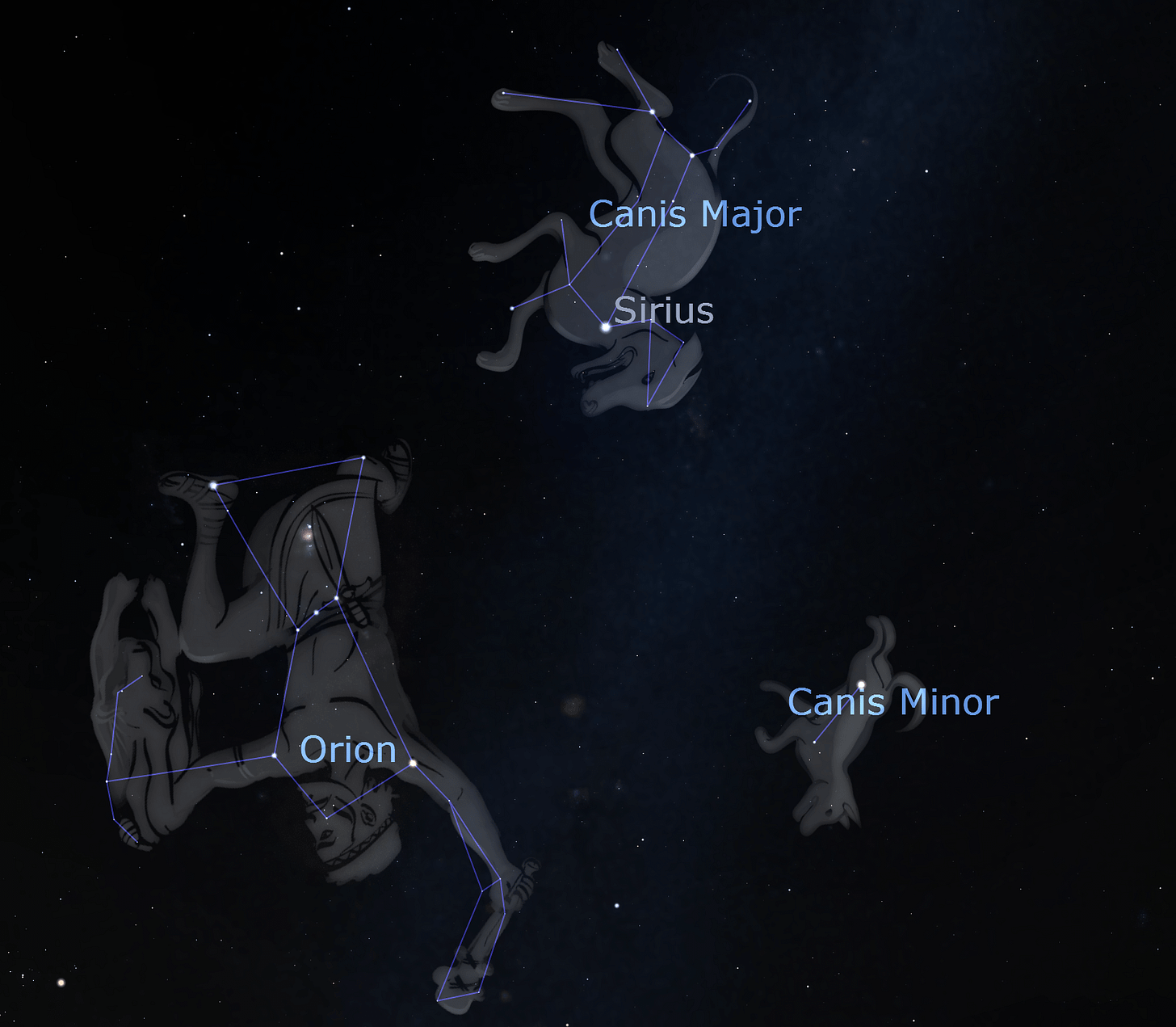
Sirius and Australia’s First People
Australia's First Peoples have been observing and studying the sky for tens of thousands of years. Their astronomical knowledge is rich and complex, and it is woven into their culture, law, and social structure. In addition to more esoteric understanding, this astronomical knowledge is used for practical purposes in seasonal calendars, marking the best times for hunting, fishing, planting, harvesting, and performing ceremonies. It is also used for navigation, with song lines mapped in the stars.
The stars, constellations and other astronomical bodies were also vital for socio-cultural reasons. Throughout many First Peoples cultures, the night sky represented the myths, stories, moral guides, lores and laws embodied in the Dreaming.
In the star lore of the Tharumba people of the Shoalhaven River,1 three stars in Canis Major formed the constellation Munowra. These stars were Wunbula (Bat) and his two wives Murrumbool (Mrs Brown Snake) and Moodtha (Mrs Black Snake). Murrumbool and Moodtha became bored of following their husband around so they tried to bury him while he was hunting a wombat down its burrow. Wunbula speared the women, and all three were raised into the sky.
These same stars were viewed differently by the Boorong people of Victoria.2 Sigma Canis Majoris was known as Unurgunite, flanked by his two wives, the stars Delta and Epsilon. Mityan (‘quoll’), the moon fell in love with Unurgunite’s furthest wife (Epsilon) and tried to lure her away but Unurgunite found out and a great fight erupted. Mityan was defeated and he has been wandering the sky ever after with the battle scars still visible on his face.3
The Boorong also placed Sirius in the centre of the constellation Warepil, the male wedge-taled eagle, chief of the elders who created the land, called the Nurumbunggootya. Warepil’s wings spread out across less bright stars on either side of Sirius. Orion’s bright star Rigel is called Collowgullouric Warepil, Warepil’s wife.4

In celebration of these ‘dog days’, let’s explore Australia’s dogs, starting with Australia's first domesticated canine species, the dingo.
The Dingo
Dingoes are not native to Australia in the strict sense, but they have been here long enough to become part of the natural ecological system, replacing the thylacine (Tasmanian tiger) on the mainland, in its role as an apex predator. Some studies suggest that dingoes arrived in Australia from Southeast Asia between 5,000 and 10,000 years ago, possibly through New Guinea. Others argue this occurred much earlier, or that dingoes may have come naturally, without human intervention.
Dingoes are important for our First Peoples, who have lived and adapted with them for thousands of years. They were not only companions but also sources of food, fur, tools and spiritual inspiration. Some dingoes were taken from wild litters and raised by First People in their camps. Others were left to roam freely and interact with humans occasionally. Dingoes have a special place in many First People’s cultures and stories, some believe that they are related to the ancestral beings who created the land.
IN TRADITIONAL Aboriginal society, women travelled with canine companions draped around their waists like garments of clothing. Dingoes played an important role in the protection and mobility of the women and children, and are believed to have greatly extended women’s contribution to the traditional economy and food supply… Dingo pups were taken from the wild when very young. The pups were a highly valued ritual food source, while others were adopted into human society. They grew up in the company of women and children, providing an effective hunting aid, a living blanket and guarding against intruders. Nursing young dingo pups was also deeply embedded in traditional customs. The Cultural History of the Dingo in Australian Geographic.
Dingoes were also revered by Australia’s First People for their ability to locate water above and below ground.
Written records, artworks and photographs in museum archives reveal dingo water knowledge as recorded by European explorers. Records reveal a number of accounts of wild/semi-wild dingoes leading Europeans to lifesaving water springs… In Australian cartography, a “Dingo Soak” refers to a waterhole dug by a mythical or live canine. There are other freshwater landmarks across the continent – “Dingo Springs”, “Dingo Rock”, “Dingo Gap”.
In Aboriginal mythology, the travels of ancestral dingoes map out songlines, graphemic maps tracing pathways across the continent from one water source to the next. Their stories tell of the formation of mountains, waterholes and star constellations. In some accounts, dingoes emerged from the ground as rainbows; in others they dug the waterholes and made waterfalls as they travelled through the landscape. The Cultural History of the Dingo in Australian Geographic.
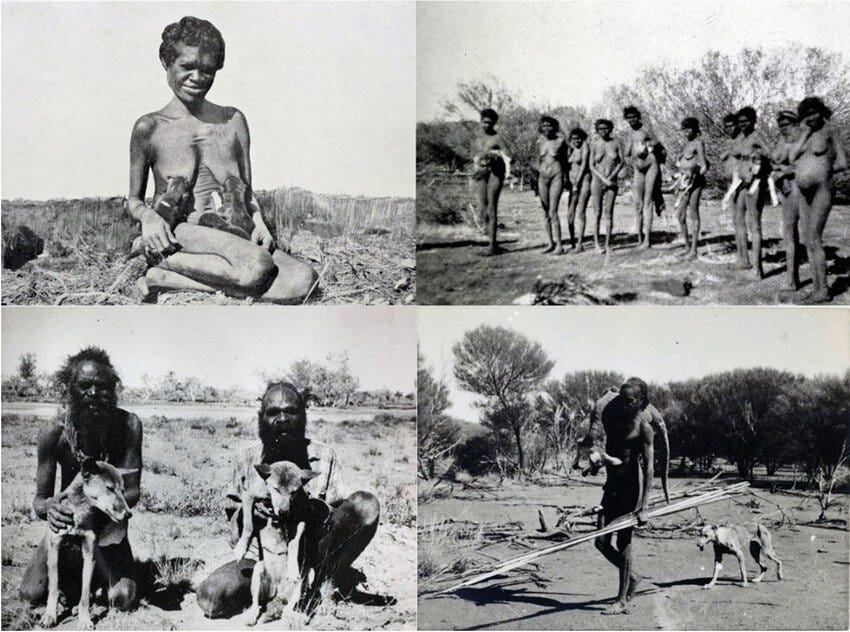
When European colonists arrived in Australia, they attempted to exterminate dingoes to protect their sheep and cattle. Dingo populations declined dramatically and although dingoes are now protected, it is no longer common to see them in the wild. However, some places such as K’gari (formerly Fraser Island) in Queensland, do have large packs of wild-roaming dingoes.
Dingoes are unique animals that deserve respect and protection. They are part of Australia's ecosystem and heritage. They are also living symbols of the long and complex relationship between humans and animals in this continent.
Australian Cattle Dog


The Australian Cattle Dog, also known as the Blue or Red Heeler is a loyal, smart, and hard-working dog. This breed was developed in Australia in the 1800s by crossing dingoes with English drover's dogs. The result was a tough and agile herding dog that could handle the harsh terrain and climate of the Australian outback.
It has a distinctive appearance, with a blue or red speckled or mottled coat and a black or tan mask. The coat is short and dense, with a thick undercoat that protects the dog from the weather. The ears are erect and alert, and the eyes are dark and expressive. It’s a medium-sized dog, weighing between 15 and 22 kg and standing between 43 and 51 cm at the shoulder.
Cattle dogs are a highly energetic and intelligent breed that needs a lot of mental and physical stimulation whether it is herding, agility, obedience, or any other activity that challenges its mind and body. It is also very independent and can be stubborn at times.
The Australian Cattle Dog is very loyal and devoted to its family, but it can be wary of strangers and other dogs. It can also be protective of its territory and possessions. It is not a good choice for families with small children or other pets, as it may nip or chase them.
Australian Heelers have recently been immortalised in the world-famous and beloved Australian children’s cartoon series, Bluey.
Australian Kelpie


The Australian Kelpie is a world-famous working dog that can herd and move stock with amazing speed, energy and tenacity. Its origins are a bit of a mystery, but there are some clues that point to its ancestry. The first dog known as a Kelpie was a black and tan female pup with floppy ears, born in 1871 near Casterton, Victoria. She was bought by Jack Gleeson, a sheepman who named her after a mythical water creature from Scottish folklore.
Gleeson later acquired another dog, a black male named Moss, who had some dingo blood in his veins. He bred Kelpie with Moss and produced a litter of pups that inherited their parents' exceptional working abilities. One of these pups, also named Kelpie, was given to C.T.W. King, who entered her in the first sheep-dog trial in Australia in 1879. She won the competition and impressed everyone with her skills.
From then on, dogs of this type were called Kelpies or Kelpie's pups, and they became very popular among Australian sheep farmers. They were also crossed with other imported collies and native dingoes to create different strains and colours. Today, the Kelpie is recognized as an official dog breed and found in many countries around the world.
The Australian Kelpie is a medium-sized dog renowned for its intelligence, alertness and eagerness to work. It can learn almost anything and thrives on challenges and new tasks. The Kelpie is also very devoted to its duty and family and will protect them from any threat. It doesn’t usually bark but will alert its owners if something is wrong. It has a lean, muscular and agile body, with a short and weather-resistant coat that comes in various colours, such as black, red, blue, fawn or chocolate. The Kelpie has a chiselled muzzle, a proportionate head and alert ears. The average height of the Kelpie is 40-51 cm and the average weight is 11-20 kg.
An Australian kelpie/cattle dog cross called ‘Red Dog’ or ‘Red’ for short became famous, and the Australian film classic, ‘Red Dog,’ was made of his exploits. Red travelled throughout the vast Pilbara region of Western Australia by himself or in the company of various owners. He was friendly and well known by many communities in the region. The Dampier Salts and Social Club and the Transport Worker’s Union made Red a member. The Bank of New South Wales even gave Red a bank account and used him as a mascot, with the slogan, “If Red banks at the Wales, then you can too.”
Sadly, Red was deliberately poisoned with strychnine in 1979. He was buried at a secret location in an unmarked grave by veterinarian Rick Fenny. A plaque commemorating the ‘Pilbara Wanderer’ is fixed to a boulder about 3.7km outside the town of Cossack in WA. Some say it lies close to where Red was buried. A statue of Red was erected in the town of Dampier in 1980.
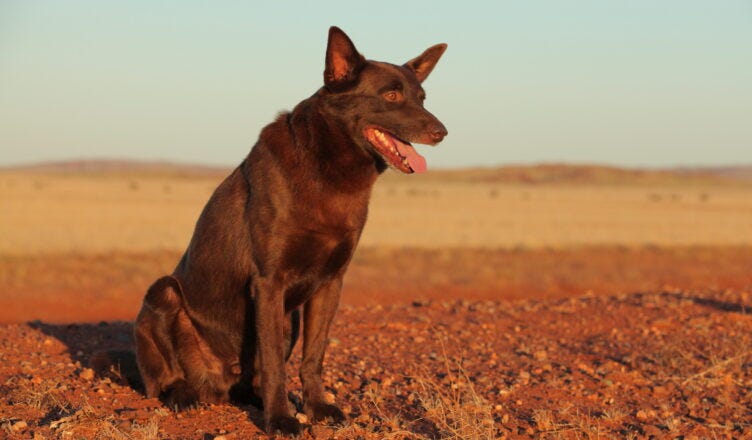
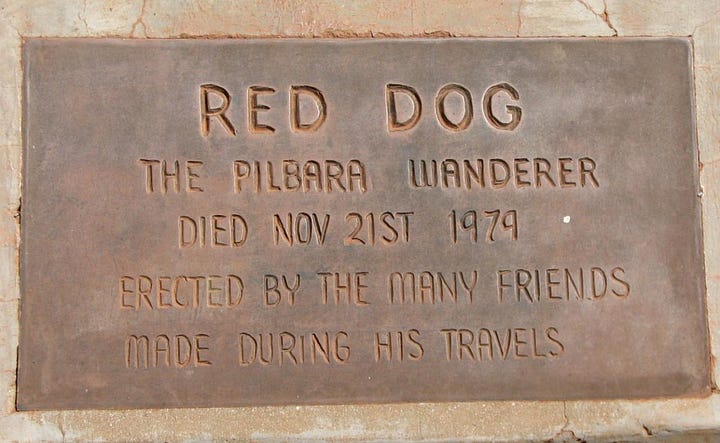
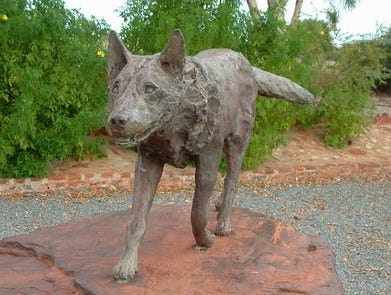
I hope you enjoyed learning about the ‘dog days’ of Summer, the ‘dog star’ Sirius, and Australia’s own wild and domesticated dog breeds. There will be a two-week break until the next episodes, which will be dedicated to the harvest season. In the meantime, I give you some seasonal wisdom:
"In the radiant realm of the dog days, every sunbeam is a storyteller, every shadow a sage." – Victoria Schwab
“Dog days teach us that sometimes, shade is all the luxury we need." – A.M. Sawyer
The video (3:42 mins) below features Florence and the Machine performing ‘The Dog Days Are Over’







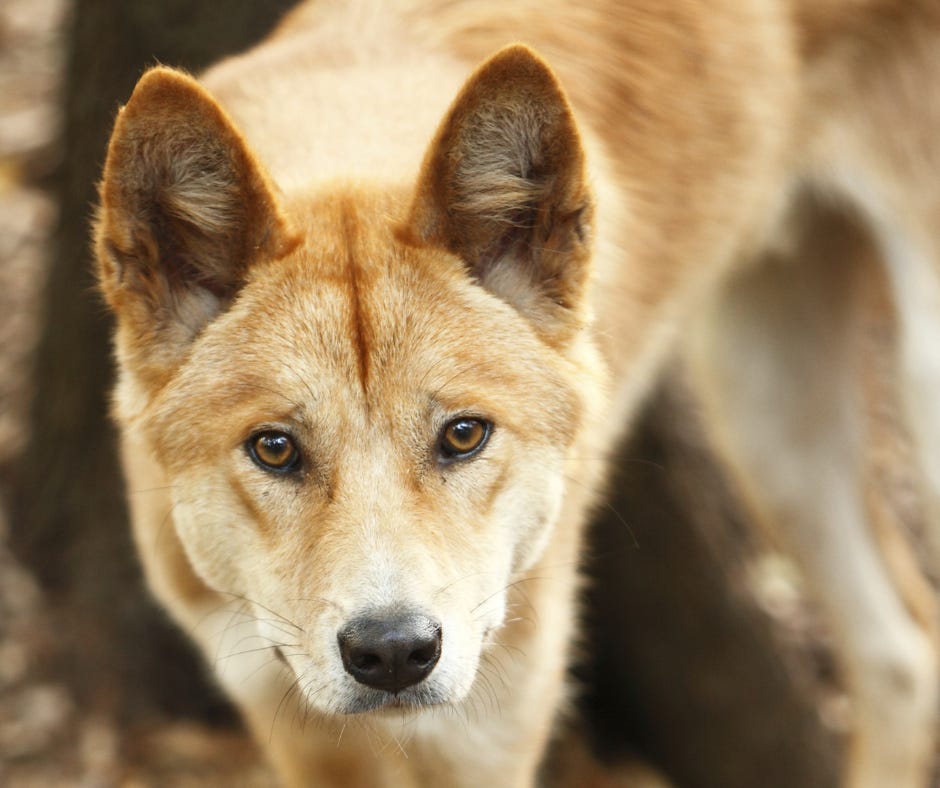









Share this post